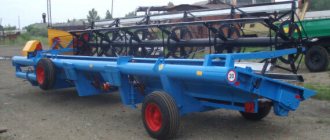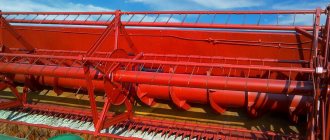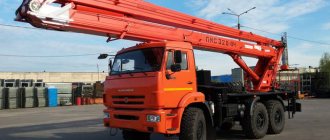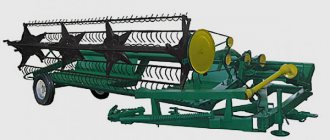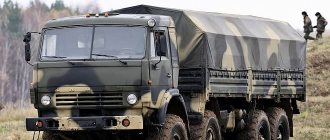A stripper header is a trailed device for harvesting grain crops. It differs from a conventional reaper in that it does not cut the stem, but combs the plant. The basis of the unit is a stripping drum, which contains rake-like elements. The combine moves across the field and lightly crushes standing plants so that they fall into the drum. This feature allows you to effectively use the header when harvesting lodged plants.
Among the advantages of the device: higher productivity (according to various sources, from 30 to 40% compared to conventional), fuel economy, and purity of the resulting grain. Among the disadvantages is that after harvesting, plant stems remain on the field that require harvesting.
With traditional harvesting technology, cutting plant stems, transporting them, deforming them during threshing and separation requires a certain amount of energy, and therefore the fuel on which the combine harvester operates.
With stripping technology, there is no such energy consumption, which makes it possible to reduce fuel consumption per ton of harvested grain by 35-40%.
The stripping reaper leaves the straw in the field, and in the grain mass it harvests, the grain makes up 80%, that is, twice as much as during traditional harvesting. This feature of the stripping header allows you to increase the speed of the combine by 2 times to 6-10 km/h, which, in turn, reduces harvesting time and reduces grain losses by shedding, and, if necessary, makes it possible to reduce the combine fleet.
Device
A stripper header is a device designed for threshing standing plants. It includes a frame on which a front drum (beater-reflector), a stripping drum and a screw conveyor are mounted. Both drums are equipped with combs. The front drum is designed to reflect the grains and transport them into the auger cavity.
The stripping drum performs the function of directly stripping standing plants. The rotation of both drums towards each other helps to create a vacuum effect necessary for aligning plant stems in the stripping area. The screw conveyor is made in the form of a shaft with turns and is designed to transport the grain mass to the inclined chamber. It is equipped with a limiting torque clutch, which prevents failure of all drive mechanisms when the auger jams. The working area of the drums and auger is covered with casings that prevent loss of grain (seeds). The drive of the working parts of the stripping device is carried out by means of a cardan shaft and chain drives.
The header is aggregated with combines by hanging it on the feeder chamber of the combine.
Making a thresher
Primitive devices to facilitate grain threshing appeared about 1000 years ago. But it would be quite difficult to use them in a combine.
Therefore, we simply must remember with a kind word the father and son Meikley from Scotland. Their drum-type device was created in 1786. Such threshers were called English or Scottish.
Mechanical threshers made work much easier and faster. Thus, in the book “American Agriculture and Livestock Raising” published in 1890 in the USA (authors Flint and Charles Louis), a description and image of a thresher of the first half of the 19th century is given. It made it possible to thresh and bag 1000 bushels (35 thousand liters or 27 thousand kg) of grain per day.
By the early 1830s of the century before last, threshing machines of various designs, mainly horse-driven, were used in the world. This invention turned out to be so revolutionary that many artists even dedicated paintings to it.
Operating principle
The principle of operation of the header is to thresh standing plants by stripping them with combs located on the stripper drum of the header. In this case, the plant stem is captured by the combs and pulled through the gap between their teeth, freeing itself from the grain (seeds). The resulting grain mass, 80% consisting of free grain (seeds), under the influence of inertial forces and air flow moves to a screw conveyor and is fed by an inclined chamber into the combine thresher for final threshing and separation.
| Technological operation | Slavyanka UAS | Classic header |
| Harvesting upright bread of normal maturity | Cleans at speeds up to 9 km/h | Cleans at speeds up to 6 km/h |
| Harvesting heavily wilted bread (barley) | Cleans with acceptable losses at high speeds | Harvesting is accompanied by large losses in the form of cut stems and ears |
| Cleaning up loaves of bread | Cleaning is possible. The header's combs allow you to lift the fallen grain. In most cases, cleaning proceeds with acceptable losses | Cleaning is accompanied by large losses or is impossible. |
| Cleaning heavily weeded fields | Cleans with acceptable losses at high speeds | Harvesting by direct combining is limited or impossible |
| Harvesting grass seeds | Removes with acceptable losses | Removes with great losses |
Staff reduction
The Berry steam harvester, like the first trailed combines, was served by up to 8 people. The first self-propelled grain harvesters with internal combustion engines already had a crew of 3 people. Many readers probably remember the time when students and even high school students could prepare well for the school year by working as an assistant combine operator. It is likely that very soon not only the assistants, but also the combine operators themselves will lose their income.
Latifundist has already talked about an unmanned tractor presented by Case IH. Laboratory tests of the “computer vision system” and software developed by Cognitive Technologies have been carried out in Russia. The company’s specialists believe that by 2023 their joint project with Rostselmash will culminate in the creation of an unmanned harvester that will be ready to go into the fields. Field tests of the first experimental model are planned for 2022.
We think it is appropriate here to recall parallel driving systems like the GPS PILOT, AUTO TURN and LASER PILOT offered by CLAAS today. And even though we are not talking about complete automation, the operator’s work is greatly simplified.
Advantages of stripper headers
| Economic | Operational | Technical |
| The stripping principle of the header allows you to reduce fuel consumption per ton of harvested grain by 40% or more | Stripping headers are universal. They can be used for harvesting many grains and forage crops | Ease of operation and design |
| A small number of wearable components and parts help minimize operating costs | The headers are characterized by high productivity and high operating speed, which can significantly reduce harvesting time | Lack of special adjustments and settings in operation |
| High purity of bunker grain reduces the cost of processing it | Effectively clears fields with laid down plants | Increased durability and reliability |
| The headers can be aggregated not only with new, but also with exhausted combines, increasing their productivity by 1.5-2 times | They have minimal mechanical impact on the grain, which ensures a low content of damaged grain |
Designed for harvesting all spiked and panicled grain crops, seed seeds of forage and medicinal herbs. Working width 5 m, 6 m and 7 m. Productivity 5 ha/hour. Soil copying mechanism. Operating speed 9 km/h. Can be aggregated with any combine harvesters. Grain loss is less than 1.5% due to design features.
Fuel savings - up to 40% compared to harvesting with traditional headers.
High-quality cleaning of fallen grain and weedy fields.
They have proven themselves to be excellent in creating stubble beds and harvesting using no-till and mini-till technologies.
Aggregation
| Slavyanka UAS-5 | Niva SK-5M, Yenisei-1200, Yenisei-1200-NM/1NM, Yenisei-950/960 |
| Slavyanka UAS-6 | Yenisei-1200-NM/1NM, Yenisei-950/960, Palesse GS812, RSM-101 “Vector-410”, ESSIL KZS-740, RSM-142 “Acros-530/560/580”, Claas Medion-310 |
| Slavyanka UAS-7 | RSM-10 "Don-1500A/1500B", KZS-9-1 "Slavutich", Case-2388, New Holland CS 6090/CSX 7050, John Deere-9500/9600/9670/W650, Claas Mega 350/360, Claas Lexion 460/540, RSM-142 "Acros-530/560/580", RSM-181 "Vector-410", RSM-181 "Torum-740", Fortschritt E517, Massey Ferguson 7256 |
Specifications
| Parameter name | UAS-5 | UAS-6 | UAS-7 |
| Working width, m | 5 | 6 | 7 |
| Productivity per 1 hour of main operating time, ha/h | 2,5-3,5 | 3-4 | 3,5-5,0 |
| Operating speed, km/h, no more | 7 | 8 | 9 |
| Total grain losses behind the header, %, less | 1,5 | 1,5 | 1,5 |
| Crushed grains,%, less | 2,0 | 2,0 | 2,0 |
| Grains (seeds) with microdamages,%, less | 2,0 | 2,0 | 2,0 |
| Bunker grain purity: - when harvesting cereal crops, %, no less - when harvesting grass seeds, %, no less | 96,0 65,0 | 96,0 65,0 | 96,0 65,0 |
| Relative reduction in fuel consumption when working with a combine harvester, %, not less | 40 | 40 | 40 |
| Number of service personnel, people. | 1 | 1 | 1 |
| Overall dimensions, m - length - width - height | 2,5 5,5 1,2 | 2,5 6,5 1,2 | 2,5 7,5 1,2 |
| Weight, kg | 1600 | 2000 | 2400 |
| Mechanism for copying soil relief | — | — | + |
It happened, the men left
Any invention appears only when it is in demand and corresponds to the prevailing socio-economic conditions. In Europe of the 2nd-1st centuries BC. The main way of redistributing material values was military raids on neighbors. Men had to take up arms more often than sickles. The need for devices to make work easier in the field was more than urgent. The reaper, pushed by a donkey, was operated by two people. Working with it was quite within the capabilities of teenagers who were not yet fit for military raids and robberies.
Alas, the excellent idea was forgotten for almost a millennium and a half; during the “dark ages” the sickle returned to the fields again.
Grain combine Akros
The Akros series of grain combines includes several models adapted to various operating conditions. The series includes combines: 550, 560, 580, 585, 590, 595.
The technological characteristics of the combine make it possible to harvest early grains, corn and sunflowers. The Acros combine harvester will be able to process up to 1000 hectares of land per season.
Among the functional features of the technology, the following can be noted:
- a super drum with a diameter of 800 mm makes it possible to work with clogged, damp, curled bread and provide 95% separation, which means a significant reduction in the risk of grain damage;
- highly reliable drive with a Posi-Torque type device, which significantly increases the productivity of the combine;
- fine adjustment required to establish the exact gap for optimal threshing. If clogging does occur, the Jam Control deep deck release device will quickly eliminate the problem.
Principle of operation
The equipment can be suspended or coupled to units. Some models work independently.
The machines have a similar principle by which they perform bevels.
- The longitudinal bars of the device capture and guide the stems to the cutting devices.
- Knives process agricultural crops.
- The processed silage ends up on the belt.
- The windrows are thrown onto the field or into the machine.
In one pass, the equipment makes a single windrow. Depending on the power of the tractor itself, the device can achieve high processing speed.
Header types:
- Mounted. Used for separate collection of agricultural crops. Cuts and forms sheaves or windrows from stems. The equipment is equipped with an ejection window and a reel with a rake.
- Trailed. Installed on tractors with the power to mow crops. Designed for those farms where the field width is small.
- Self-propelled. A functional model that cuts the stems and then picks them up. As a result, raw material losses are reduced and work productivity increases.
- Combing. The header of a combine harvester uses innovative methods for harvesting grain crops. It acts on the ears, leaving the stems intact. These minimize fuel consumption and equipment wear.
It is advisable to select equipment depending on the width of the field, landscape features, and type of unit
Farmers pay attention to the design features of the models. Then you can perform work with high efficiency and productivity
Pilotdrive technology
But domestic developers give preference to space technologies. The operating principle of the Pilotdrive system proposed is clear from the illustration. And this is not just a concept - the autopilot was successfully tested in 2016, although so far only on the Lanos car. Perhaps a domestic unmanned harvester is not such a fantasy.
Types of grain combines
There are a huge number of different types of grain combines, each of which is suitable for certain conditions and has its own pros and cons. Let's take a closer look at each type.
Based on the principle of operation, grain combines are divided into:
- Drums. This type of combine is a classic one and is the one that is used most often. This is one of the simplest and most inexpensive types of combines. Such combines are capable of working in so-called “difficult conditions”, for example, with large grain fields, which can be quite difficult to do with other types of combines.
- Rotary. Grain combines of this type work quite quickly. This technique is more effective when harvesting large crops. The main disadvantage of a rotary harvester is energy consumption. Such a combine consumes a large amount of fuel, so it is not always used for harvesting. The price for this type of combine is significantly higher than for others.
- Hybrid. This is one of the most popular options. This combine combines both a drum and a rotary motor. This combine works quickly and accurately. The hybrid harvester can work with large grains and is not afraid of morning dew. The price of such a combine is average, which allows it to be actively used during harvesting.
According to the aggregated method, grain combines are divided into the following categories:
- Self-propelled. As you know, this is one of the most common types of combines that are actively used for harvesting grain crops.
- Mounted. Quite often used for harvesting.
- Trailed. This type of combine requires a tractor, since it only works together with it.
Manufacturers and suppliers of grain combines
Russia is constantly increasing the pace of development of the agricultural sector.
Therefore, grain combines are quite popular equipment, the production and supply of which is carried out by different companies:
- Rostselmash is a leader among domestic manufacturers of universal grain harvesters. The following models come off the production line: RSM 161, TORUM 780 | 750, ACROS 595, ACROS 585/550, VECTOR 450 Track, VECTOR 425/410 and adapters. Rostselmash has a large dealer network in Russia and abroad;
- , part of the Tractor Plants concern, produces grain combines AGROMASH 5000, AGROMASH 4000, AGROMASH 3000;
- CJSC JV "Bryanskselmash" offers grain harvesters KZS-812, KZS-1218, KZS-10K and KZS-1218A-1, as well as service, repair and supply of spare parts;
- CJSC Agrotekhmash - TERRION - specializes in the supply of agricultural machinery and spare parts for them. The company supplies combine harvesters of the SR2010, SR2000, SR3000, SR3085 SUPERIOR series.
In the Russian Federation there are factories of such leading world holdings as CASE IN, New Holland, AGCO.
Many manufacturers and suppliers of grain combines participate in the annual Agroprodmash exhibition.
Russian-made grain harvestersForage harvesters
Grain mini-harvester Zarya
The Zarya grain mini-harvester is an ideal solution for cleaning small areas. The minimum weight of the combine allows you to work on loose soil without causing rutting. Due to the lateral discharge of finished grain, the combine can work in conjunction with trucks. Design features allow for harvesting low-growing crops and ensuring high cross-country ability in the fields.
An important difference from other equipment is that the Zarya mini-harvester does not have a cabin, but is equipped with a driver’s seat, which, if necessary, is complemented by a flexible roof. The Zarya mini-harvester has a budget price and low fuel consumption, due to which this equipment is very popular among farmers
The Zarya mini-harvester has a budget price and low fuel consumption, due to which this equipment is very popular among farmers.
Imported components
- Linear actuators.
- SKF bearings
- Headlights.
All other consumables are produced and available at our factory. The components and assemblies of the header are covered by a 12-month warranty from the date of sale. Purchased products are covered by the warranty period stated by the manufacturer. When purchasing a header, the manufacturer guarantees free 3-day support, training and free 12-month consultation by a specialist by telephone. When ordering 1 header, 100% prepayment, production time is 15-20 working days. When ordering 2 or more headers, an advance payment of 50% is required; production time varies depending on the quantity of products ordered.
Day after tomorrow
Another agricultural revolutionary is the Tribine Harvester combine. It implements a completely new approach to solving the problem of grain harvesting and processing. A hopper with a capacity of approximately 27 tons of wheat can be emptied in just 2 minutes. Operating time without refueling is at least 24 hours. The use of a separate bin freed up space for an innovative grain cleaning system. Thanks to the articulation of the modules, the Tribine's maneuverability is better than most modern models.
Since 2022, company specialists have been working to solve the problem of reducing the load on the land. The possibility of using jet propulsion is not excluded. As we see, the agricultural future is being born today.
Andrey Beskorsy,
Everyone can have a hand in creating a high-tech future for the agricultural sector! The Kernel agricultural holding invites Ukrainian innovators to cooperate.
Mounted mower for direct cutting of grass and bread
Bread harvesting begins with mowing. Horse-drawn mowers (Fig. 1) appeared almost simultaneously in Germany, Russia, and France. They implement the basic principles of cutting that are still used today. The mower has movable blades and shear plates. The movable knife makes reciprocating movements. The stem is clamped between the knife and the plate and then cut. Subsequently, it falls outside the knife plates.
General view of the horse-drawn mower: 1 – seat; 2 – platform; 3 – wheel; 4 – increasing gearbox; 5 – crank; 6 – folding mower blade; 7 – movable knife; 8 – fixed shear plate on the folding blade; 9 – locks the mower blade in the transport position.
To ensure high speed of the blades on the mower blade, a two-stage gearbox is used, in which the rotation speed increases six times. The crank converts rotational motion into reciprocating motion. It is transmitted by traction to the block of movable knives.
In many countries, horse-drawn mowers are still produced today; if you have horses on your farm, you can purchase a similar horse-drawn mower. On average, such a mower can mow at least 10 hectares of grain per day. Usually two people work, one mows, and the other puts the hay into a windrow with a rake.

